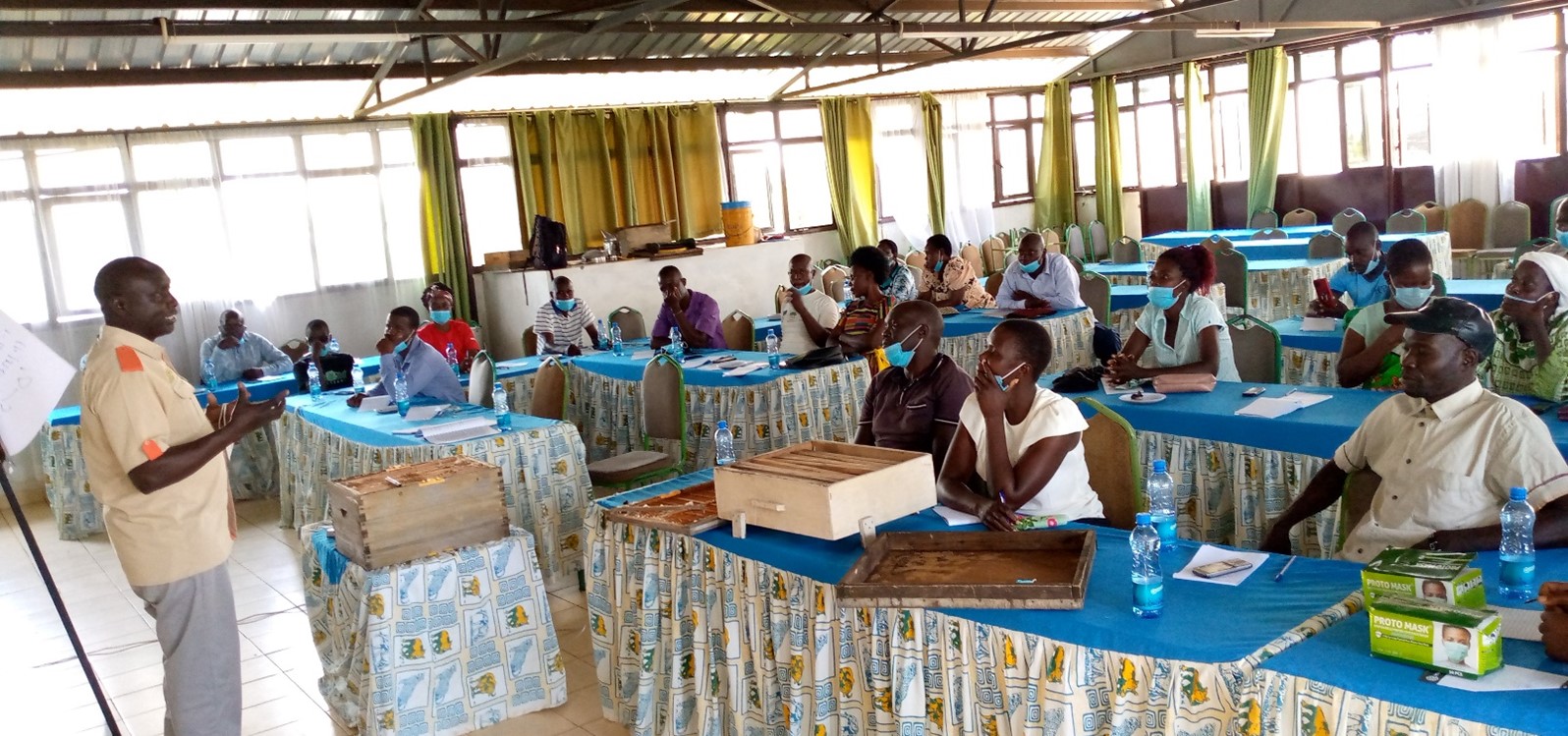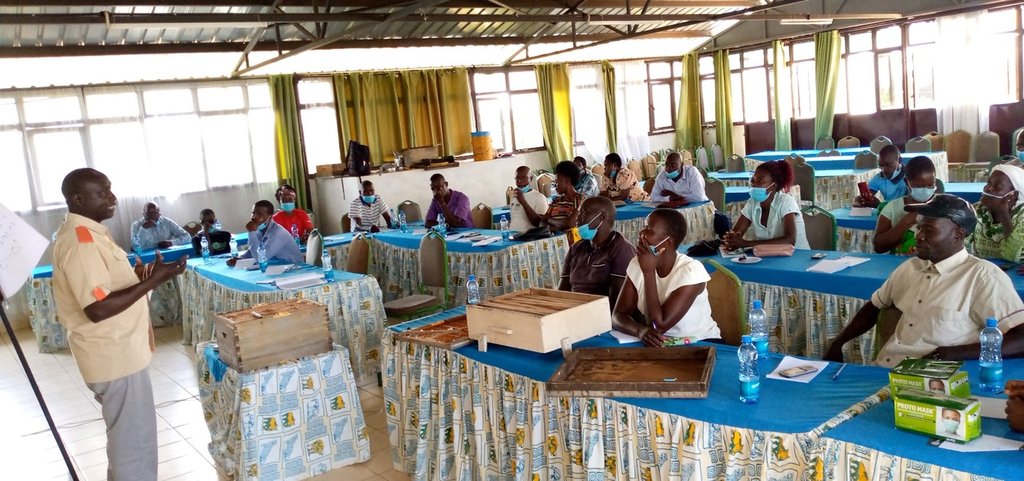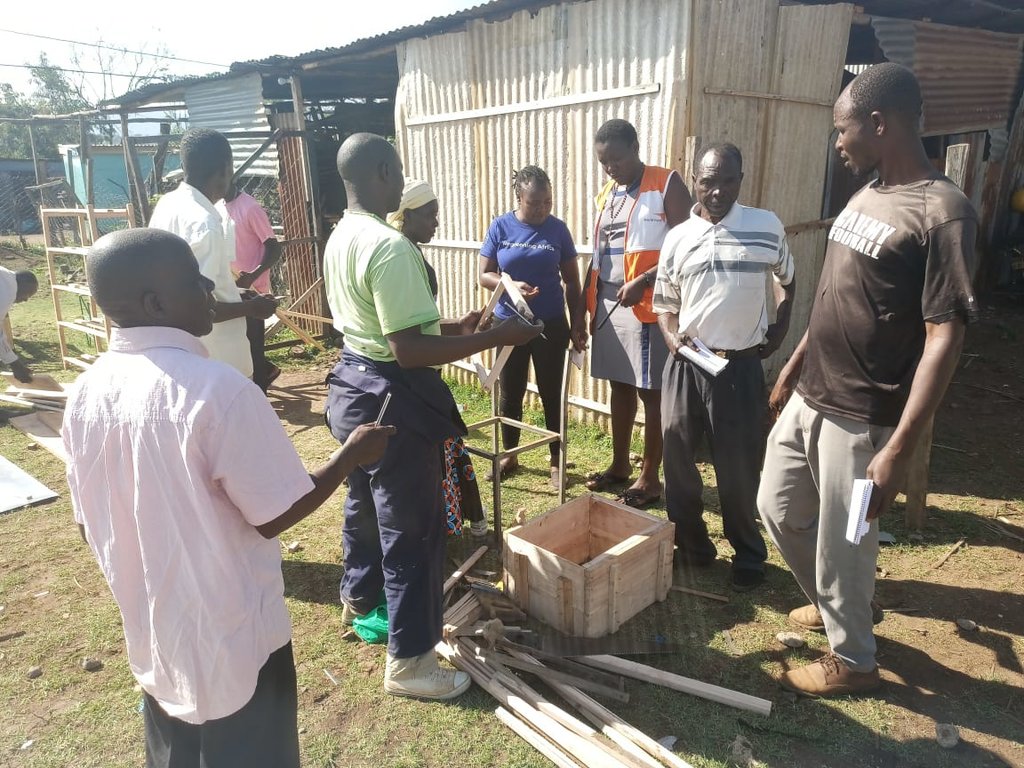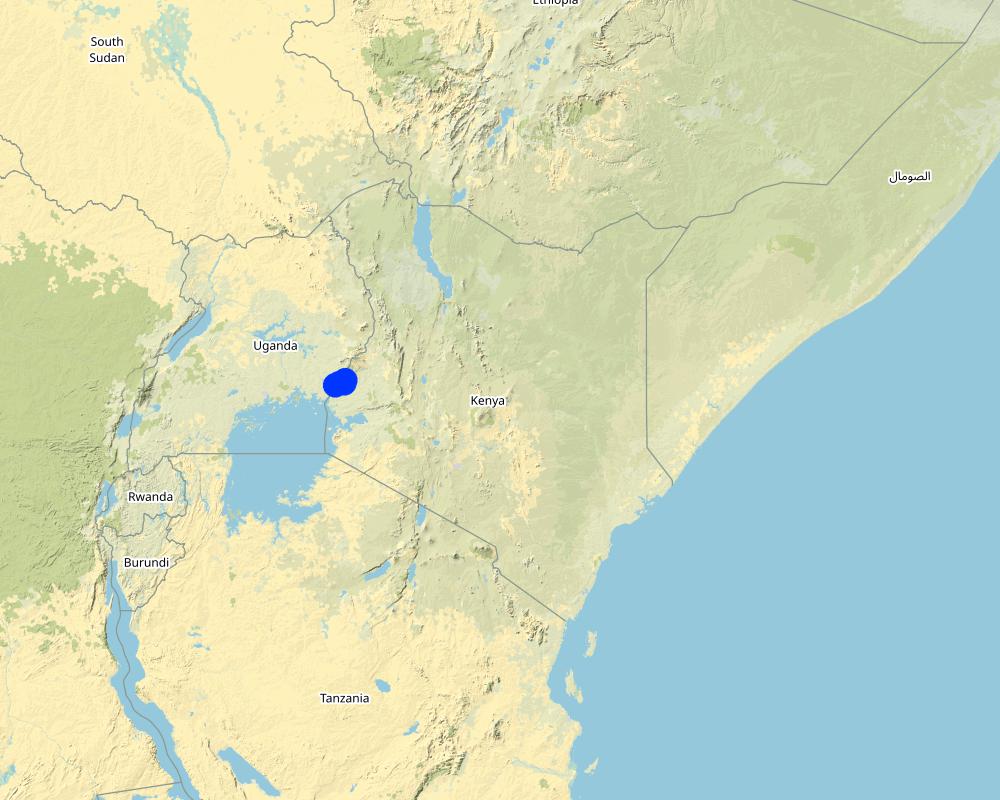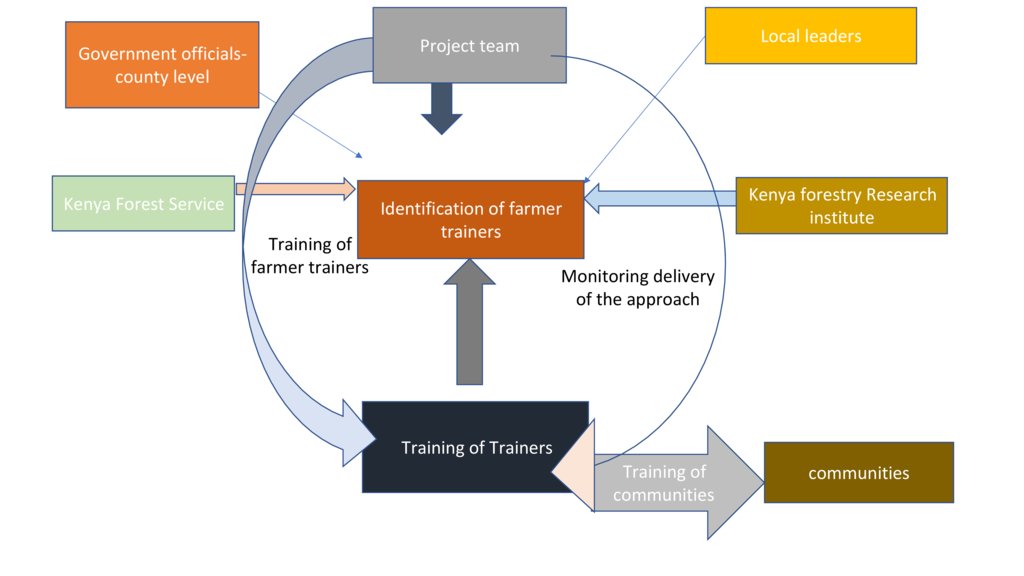Training of Trainers for land restoration through beekeeping [肯尼亚]
- 创建:
- 更新:
- 编制者: Grace Koech
- 编辑者: –
- 审查者: William Critchley, Rima Mekdaschi Studer
Training of Trainers (ToTs)
approaches_6624 - 肯尼亚
查看章节
全部展开 全部收起1. 一般信息
1.2 参与方法评估和文件编制的资源人员和机构的联系方式
关键资源人员
co-compiler:
Wambua Brian
+25474608042 / +254707340669
brian_wambua@wvi.org
World Vision Kenya
brian_wambua@wvi.org
肯尼亚
有助于对方法进行记录/评估的项目名称(如相关)
Reversing land degradation in Africa by scaling-up Evergreen Agriculture (Regreening Africa)有助于对方法进行记录/评估的机构名称(如相关)
International Centre for Research in Agroforestry (ICRAF) - 肯尼亚1.3 关于使用通过WOCAT记录的数据的条件
(现场)数据是什么时候汇编的?:
13/12/2022
编制者和关键资源人员接受有关使用通过WOCAT记录数据的条件。:
是
2. SLM方法的描述
2.1 该方法的简要说明
The Regreening Africa project identifies key individuals within the community who are then trained on land restoration through beekeeping. Through this "training of trainers" approach the trainees then train others.
2.2 该方法的详细说明
该方法的详细说明:
The Regreening Africa project identifies key individuals within communities who are trained on land restoration through beekeeping: the trainees then train others themselves. The characteristics of this “training of trainers” (ToT) approach is that it is community-based, and those selected for training work within areas they can reach with ease from their homes. They are also required to be practicing, or demonstrating interest in, one or more approaches promoted by the project. The selected persons include women, the disabled, and youth, as well as mature people who have the experience to integrate local knowledge.
The objectives of the approach are to cut down on the cost of implementing land restoration by building capacity at the local level. By promoting peer-learning and establishing learning sites within the community, it is believed that a greater number of people can be efficiently reached. The goal is to achieve more trees on farms (especially "bee-friendly" trees) and increased sales of honey and other products, leading to better living standards and a sustained, healthy environment.
Training includes technologies that cover tree growing (including farmer managed natural regeneration) with an emphasis on beekeeping as a commercial venture within a promising value chain. Thus, they are trained specifically on beekeeping as well as hive making to meet the high demand for honey. They are supported with high value seed and tree seedlings for integration into farms to support their apiary businesses. The main stakeholders involved include World Vision Kenya who mobilize farmers and link them to other actors in beekeeping value chains; ICRAF who provide training on beekeeping and hive making, as well as technologies for tree growing and management; and county government who have constituted a forum to regulate prices. Communities then implement the technologies. Initially the farming communities disliked bees due to possible attacks, but after training about setting up apiaries and bee-based businesses, and based on their experience after implementing the lessons learnt from the training, they have become more receptive to the approach.
2.3 该方法的照片
2.4 该方法的视频
注释、简短说明:
we did not take any videos for this technology
2.5 采用该方法的国家/地区/地点
国家:
肯尼亚
区域/州/省:
Homabay
Map
×2.6 该方法的开始和终止日期
注明开始年份:
2020
若不知道准确的年份,请注明该方法的大致开始日期。:
不到10年前(最近)
注释:
The technology was going on in some part of the project sites, however the communities lacked the skills on bee colony management, ensuring sufficient bee forage and importance of environmental health for increased production of hive products.
2.7 方法的类型
- 基于项目/方案
2.8 该方法的主要目的/目标
To enable communities benefit from the land restoration approaches, equally reach many people with the technology and build local resources and capacities.
2.9 推动或妨碍实施本办法所适用的技术的条件
社会/文化/宗教规范和价值观
- 启动
The approach provides incentive for farmers to learn from other farmers
财务资源和服务的可用性/可得性
- 启动
implementors can access loans from the local self help groups to expand the approaches. further implementors are parts of saving and loaning groups to allow them save and invest in the technology.
机构设置
- 启动
Homabay county generated a platform that allows actors to discuss matters relating to the value chain such as prices. further, the county link the actors to other initiatives funded by donors.
参与者的的协作/协调
- 启动
actor forums are in place and functional
法律框架(土地使用权、土地和水使用权)
- 启动
local bylaws are used
政策
- 启动
activities are aligned to existing policies
土地治理(决策、实施和执行)
- 启动
land tenure in the area is individual, household level discussion incorporates contributions from all the members.
了解SLM,获得技术支持
- 启动
the actors are empowered through training, further demonstration plots were established and knowledge products produced to support the actors. others ways of building actors capacity is through the stakeholder forum that has diverse expertise.
市场(购买投入,销售产品)和价格
- 启动
markets are available, actors are unable to meet the current demand
工作量、人力资源可用性
- 启动
beekeeping is not labor intensive
3. 相关利益相关者的参与和角色
3.1 该方法涉及的利益相关者及其职责
- 当地土地使用者/当地社区
land owners
provide labor, manage the technology, contribute local knowledge
- 社区组织
community champions, village loaning and saving association
local experts, share lessons on SLM, provide loans and opportunities for saving
- SLM专家/农业顾问
County extension agents
provide training and linkages
- 研究人员
International NGOS, universities, local NGOs
provide technical support, provide research funds
- 教师/学龄儿童/学生
school clubs, patrons, environmental enthusiast
implement technologies, scale the knowledge through skits, songs and poems
- 私营部门
private nurseries
provide seedlings
- 地方政府
county government constituted a forum to regulate prices
如果涉及多个利益相关者,请注明领导机构:
ICRAF
3.2 当地土地使用者/当地社区参与该方法的不同阶段
| 当地土地使用者/当地社区的参与 | 指定参与人员并描述活动 | |
|---|---|---|
| 启动/动机 | 互动 | local community consultation was conducted to determine the land restoration issues. community opinion leaders, community representatives and local leaders are involved. |
| 计划 | 互动 | planning is facilitated by the implementing NGO, communities generate the plans |
| 实施 | 互动 | community are enabled to implement through trainings and provision of some material as they also contribute part of the materials. |
| 监测/评估 | 外部支持 | internal monitoring systems are in place to enable communities adapt to changes to implementation. External reviewers are involved to assess impacts of the intervention. |
3.3 流程图(如可用)
具体说明:
government, project team, community leaders identify project stakeholders to be trained, trained farmers train other farmers.
作者:
Grace Koech
3.4 有关SLM技术选择的决策
具体说明谁有权决定选择要实施的技术:
- 所有相关参与者,作为参与式方法的一部分
解释:
participatory approaches are adopted for ownership and adoption, communities understand their landscape and own indigenous knowledge and history of what works and what does not. expert bring additional knowledge to improve the local practices, counties provide linkage for external support to strengthen the approach further.
明确做出决策的依据:
- 对充分记录的SLM知识进行评估(基于证据的决策)
4. 技术支持、能力建设和知识管理
4.1 能力建设/培训
是否为土地使用者/其他利益相关者提供培训?:
是
明确受训人员:
- 土地使用者
- 现场工作人员/顾问
如果相关,请说明性别、年龄、地位、种族等。:
Males, females and youth are involved in the training, ensuring women form 30% of the trainees and trainees ages ranged between 8-60 years. Usually training is conducted at local level and most of the communities are of the same ethnic group.
培训形式:
- 在职
- 农民对农民
- 示范区域
- 公开会议
涵盖的主题:
Beekeeping for land restoration, tree nursery establishment and management, honey value chain development
注释:
The approach is specific to beekeeping for land restoration
4.2 咨询服务
土地使用者有权使用咨询服务吗?:
是
指明是否提供了咨询服务:
- 在土地使用者的土地上
说明/注释:
farmers convene at a common place to learn about a specific technology.
4.3 机构强化(组织发展)
是否通过这种方法建立或加强了机构?:
- 是,少许
具体说明机构的强化或建立程度:
- 本地
说明机构、角色和职责、成员等。:
local farmer groups have been registered to enable them receive recognition and financial support from micro credit institutions
具体说明支持类型:
- 财务
- 能力建设/培训
- 设备
提供进一步细节:
farmer groups develop proposals that they present to financial institutions or other NGOs to allow them access fund, some institutions provide equipment
4.4 监测和评估
监测和评估是该方法的一部分吗?:
是
注释:
approach is reviewed periodically to allow actors adapt to prevailing situations.
若是,该文件是否用于监测和评估?:
是
注释:
The information help the planners to decide on better ways to improve the technology
4.5 研究
研究是该方法的一部分吗?
否
5. 融资和外部物质支持
5.1 该方法中SLM组成部分的年度预算
如果不知道准确的年度预算,请给出一个范围:
- 2,000-10,000
注释(例如主要的资助来源/主要捐助者):
EU
5.2 为土地使用者提供财政/物质支援
土地使用者是否获得实施该技术的财政/物质支持?:
是
如果是,请具体说明支持的类型、条件和提供者:
The training of trainers were facilitated using the project funds to attend trainings.
5.3 对特定投入的补贴(包括劳动力)
- 农业
| 具体说明哪些投入得到了补贴 | 程度如何 | 对补贴做出具体说明 |
|---|---|---|
| 种子 | 部分融资 | Training of trainers received training on nursery establishment and were supported with seeds of preferred species. |
如果土地使用者的劳动力是一项重要的投入,那么是不是:
- 自愿
5.4 信用
是否根据SLM活动的方法给予信用值?:
是
对条件(利率、回报等)进行具体说明:
The training of trainers accessed credit through the self-help groups. The interest rates varies from 1-10% depending on the saving groups. most of the training of trainers saved in more than more saving and loaning group.
请具体指明授信方:
self help groups
请具体指明信贷接收人:
Training of Trainers and local communties
5.5 其它激励或手段
是否有其他激励措施或工具用于促进SLM技术的实施?:
是
如果是,请具体说明:
Recognition, best performing training of trainers were visited by the donors and other partners to learn from the approach. that gave them a sense of prestige and motivation and challenged the other ToTs to do better so next time they receive visitors.
6. 影响分析和结论性陈述
6.1 方法的影响
该方法是否有助于当地土地使用者,提高利益相关者的参与度?:
- 否
- 是,很少
- 是,中等
- 是,支持力度很大
beekeeping for land restoration is widely adopted in Homabay county.
这种方法是否有助于基于证据的决策?:
- 否
- 是,很少
- 是,中等
- 是,支持力度很大
incentives for land restoration was a major learning from the approach
该方法是否帮助土地使用者实施和维护SLM技术?:
- 否
- 是,很少
- 是,中等
- 是,支持力度很大
yes, beekeeping generate food and income for the households that encouraged them to scale and maintain the integrity of the environment.
该方法是否提高了SLM的协调性和成本效益?:
- 否
- 是,很少
- 是,中等
- 是,支持力度很大
the cost incurred was training, which was also done at the local level
该方法是否调动/改善了使用财务资源实施SLM的途径?:
- 否
- 是,很少
- 是,中等
- 是,支持力度很大
some groups were able to get loans from the loaning and saving groups
该方法是否提高了土地使用者实施土地管理的知识和能力?:
- 否
- 是,很少
- 是,中等
- 是,支持力度很大
yes through peer learning, knowledge products, experience from implementation
该方法是否提高了其他利益相关者的知识和能力?:
- 否
- 是,很少
- 是,中等
- 是,支持力度很大
presentation of the approaches and interactive sessions during joint learning and reflection meetings
该方法是否建立/加强了机构、利益相关者之间的合作?:
- 否
- 是,很少
- 是,中等
- 是,支持力度很大
through the value chain platforms the stakeholders were able to identify others opportunities for linkages and partnership.
该方法是否缓解了冲突?:
- 否
- 是,很少
- 是,中等
- 是,支持力度很大
该方法是否有助于社会和经济弱势群体?:
- 否
- 是,很少
- 是,中等
- 是,支持力度很大
the approach is inclusive
the approach is inclusive
the approach is inclusive
该方法是否改善了阻碍SLM技术实施的土地使用权/用户权问题?:
- 否
- 是,很少
- 是,中等
- 是,支持力度很大
youths and women were allowed to practise SLM on family land
该方法是否改善了粮食安全/改善了营养?:
- 否
- 是,很少
- 是,中等
- 是,支持力度很大
bees provide honey that is used as food. trees foraged on by trees also provided other products such as fruits and product sold to generate income.
该方法是否改善了市场准入?:
- 否
- 是,很少
- 是,中等
- 是,支持力度很大
through linkages and sharing of market information
该方法是否改善了供水和卫生条件?:
- 否
- 是,很少
- 是,中等
- 是,支持力度很大
该方法是否带来了更可持续的能源使用?:
- 否
- 是,很少
- 是,中等
- 是,支持力度很大
through trainings on FMNR farmers are able to access pruning for use as firewood and reducing destruction of the entire tree
该方法是否提高了土地使用者适应气候变化/极端情况和减轻气候相关灾害的能力?:
- 否
- 是,很少
- 是,中等
- 是,支持力度很大
crop failure due to unreliable rains are mitigated through use of tree crops established on farms and reduced surface runoff improving rainfall productivity.
该方法是否会带来就业、收入机会?:
- 否
- 是,很少
- 是,中等
- 是,支持力度很大
for nursery operators, fruit sellers, honey producers and processors
6.2 土地使用者实施SLM的主要动机
- 增加生产
by increasing diversity and number of trees onfarms bees access more forage and higher production
- 增加利润(能力),提高成本效益比
using inbuilt skills to make hives, reduces the cost of buying hives and hence the cost of production greatly reduced.
- 减少土地退化
understanding the relationship between environment integrity and honey productivity enabled communities aspire to restore more land for better quality and quantity of honey produced.
- 降低灾害风险
food insecurity risk reduced due to access of honey
- 加入运动/项目/团体/网络
importance of village loaning and saving groups to facilitate access to finance to support SLM
- 环境意识
- 提高SLM知识和技能
understanding the relationship between environment integrity and honey productivity enabled communities aspire to restore more land for better quality and quantity of honey produced.
6.3 方法活动的可持续性
土地使用者能否维持通过该方法实施的措施(无外部支持的情况下)?:
- 是
若是,请说明如何维持:
sustainability is integral part of the approach, the approach thus build local institutions structures to ensures the technology is implemented with or without the external support
6.4 该方法的长处/优点
| 土地使用者眼中的长处/优势/机会 |
|---|
| inclusive |
| participatory |
| stakeholder led |
| 编制者或其他关键资源人员认为的长处/优势/机会 |
|---|
| inclusive |
| stakeholder led |
| participatory |
6.5 该方法的弱点/缺点以及克服它们的方法
| 土地使用者认为的弱点/缺点/风险 | 如何克服它们? |
|---|---|
| need strong leadership to succeed | leaders that are visionary should be appointed |
| 编制者或其他关键资源人员认为的弱点/缺点/风险 | 如何克服它们? |
|---|---|
| change of role/ change of government incase of county officials | ensure proper hand over and induction for continuity |
7. 参考和链接
7.1 方法/信息来源
- 根据报告和其他现有文档进行编译
7.2 参考可用出版物
标题、作者、年份、ISBN:
Regreening Africa annual reports
可以从哪里获得?成本如何?
open access
7.3 链接到网络上可用的相关信息
标题/说明:
Regreening Africa project
URL:
https://regreeningafrica.org/
链接和模块
全部展开 全部收起链接
无链接
模块
无模块


